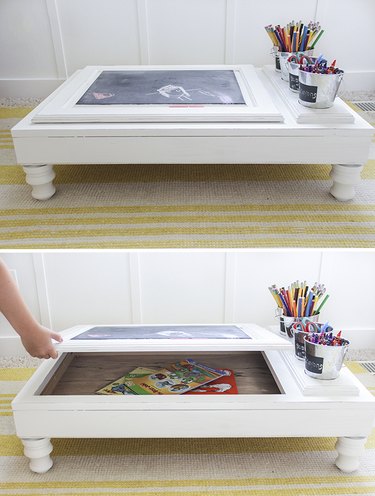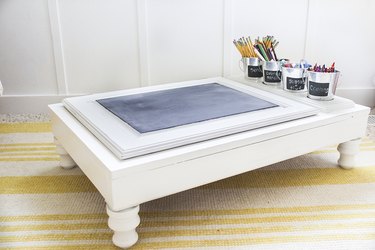With kitchen remodels happening all the time, many old cabinets are either thrown away or donated. Instead of tossing them out at the thrift store, repurpose them into a portable desk for your elementary-aged child. This desk provides a large work surface, a chalkboard, a storage compartment for papers and books, as well as holders for all kinds of school supplies.
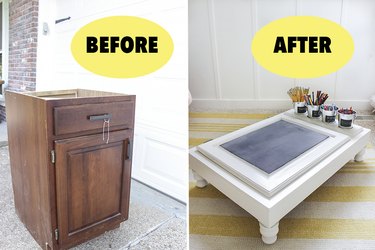
Video of the Day
Things You'll Need
Cabinet with one door and one drawer
Mallet or hammer
Phillips screwdriver
Needle-nose pliers
Measuring tape
One-by-three pine board, 100 inches or enough for perimeter of cabinet face
Circular saw
Cordless drill/driver
Pocket hole joinery system
Wood glue
1 1/4-inch pocket hole screws
1/4-inch plywood, cut to dimensions of cabinet face
1/2-inch long nails (if using nail gun, use 18 gauge)
Pneumatic or electric nail gun (optional)
Pencil
Small plastic cups, 4
Self-feed drill bit, 1-inch diameter
Jigsaw
Wood clamp
Wood filler
Sandpaper, 150 and 220 grit
Orbital sander (optional)
Router with router table (optional)
1/2-inch core-box or round nose router bit (optional)
Cabinet knob, 1 (optional)
Table leg straight top mounting plate, 2 1/2 inches wide, 4
Wooden furniture feet, 4 inches tall, 4 (can use taller feet, depending on preference)
2-inch paintbrush
Paint + primer latex paint, white, semi-gloss
3-inch foam roller brush
Chalkboard paint
Small tin buckets, 4
Step 1: Disassemble the Cabinet
Using a mallet or hammer, remove the back of the cabinet from the cabinet face. If drawer slides are attached to the cabinet face inside the cabinet, remove them with a Phillips screwdriver. Use the mallet to loosen the sides and bottom of the cabinet from the cabinet face, as well as the drawer sides and bottom from the drawer face. Needle-nose pliers may be used to remove any staples. Remove pulls or knobs with a screwdriver.
Video of the Day
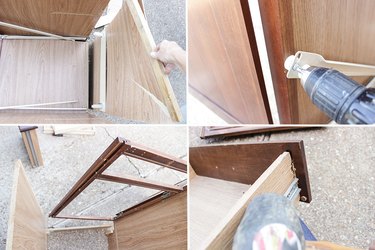
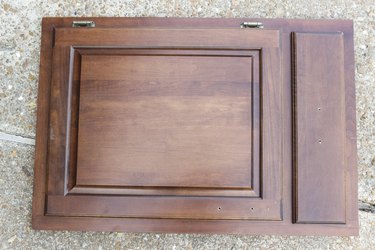
Step 2: Build the Desk Base
Measure the length and width of the cabinet face. Using a circular saw, cut a one-by-three pine board into two long pieces that are equivalent to the length of the cabinet face and two short pieces that are 1 1/2 inches shorter than the width of the cabinet face. For example, the cabinet face used in this tutorial is 31 inches long and 21 inches wide. Two boards were cut at 31 inches and two boards were cut at 19 inches. Adjust these measurements depending on the size of your cabinet face.
Drill 3/4-inch pocket holes along the long pieces of wood, spaced about 4 to 5 inches apart. Drill 3/4-inch pocket holes along the long side of the short pieces of wood, and then two pocket holes on either end. Use wood glue and 1 1/4-inch pocket hole screws to screw the short boards to the inside of the long boards so that a box is formed.

Step 3: Attach Desk Base to the Cabinet Face
Using 1 1/4 inch-pocket hole screws and wood glue, attach the desk base to the underside of the cabinet face. Work slowly and do not drive the pocket hole screws too deep so they poke out the other side. Then cut a piece of 1/4-inch plywood to the same dimensions as the cabinet face and attach it to the underside of the desk base with wood glue, 1/2-inch nails and a hammer, spacing nails every 3 inches along the perimeter. An optional alternative to the hammer and nails would be to use a pneumatic or electric nail gun and 18 gauge 1/2-inch nails.
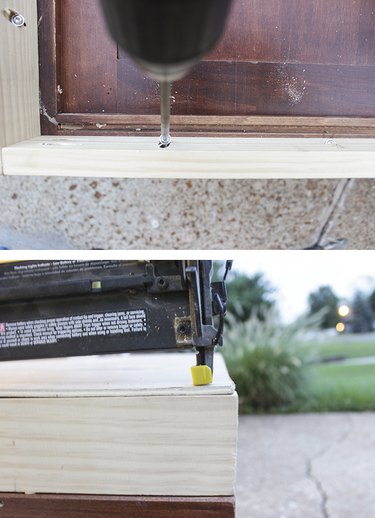
Step 4: Make Holes in the Drawer Face
Using cups or small tin buckets as a template, trace four evenly-spaced circles on the drawer face. If tracing from the base of the cup or bucket, draw the circle about 1/2 inch larger than the actual diameter. Drill holes along the edge of the diameter of the circles with a 1-inch self-feed drill bit, and then use a jigsaw to slowly cut along the perimeter of the circle. Repeat for the remaining three circles.
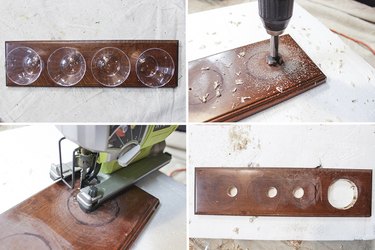
Tip
While drilling holes and cutting circles in the drawer face, a large (3 inch or thicker) piece of polystyrene can be used to work on top of. The polystyrene will not affect performance of the jigsaw and is sturdy and hard enough to provide adequate support to the drawer face while making the cuts.
Step 5: Attach Drawer Face to the Cabinet Face
Place glue along the underside edges of the drawer face and carefully position it on top of the cabinet face over the drawer opening. Use a measuring tape if necessary to make sure placement is even on all sides. Clamp the drawer face to the cabinet face and let it dry overnight.

Step 6: Attach Knob to Cabinet Door or Route the Edge
If the cabinet door sits flush with the cabinet face when closed, a knob will need to be attached to easily open the desk. Measure, mark and drill a hole in the center long edge of the cabinet door (the unhinged side) so that it will not interfere with left- or right-handed children. Attach the knob.
Another option is to route the long edge of the cabinet door so a lip is formed for easier opening of the desk. To do this, position the router table guide at 0 inches so half of the round nose bit cuts into the edge of the door. Remove the screws from the hinges on the cabinet door and slide it along the router table, following the manufacturer's instructions. Once the door has run through twice (to ensure an even cut along the entire long edge), sand the cut edges with 220 grit sandpaper to remove splinters.
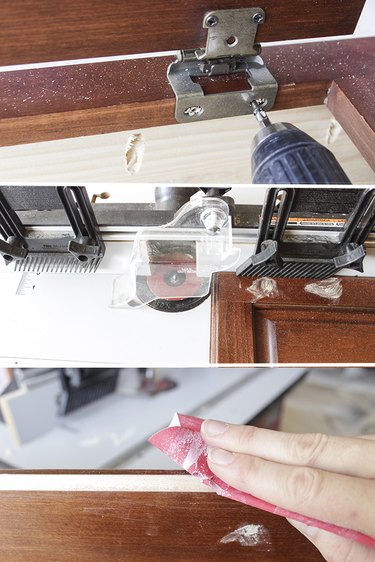
Step 7: Fill Holes and Sand the Desk
Use wood filler to fill the holes from the cabinet pull, seams and places where the desk base join with the cabinet face. Let it dry for several hours. Sand the pre-finished cabinet door, drawer and base with 150 grit sandpaper by hand, or use an orbital sander to remove the protective finish and make it easier for paint to adhere to the surface. Sand the areas where wood filler was used and all edges with 220 grit sandpaper to ensure there are no sharp corners or splinters.

Step 8: Attach Feet to the Desk
On the four corners under the desk base, mark and pre-drill holes for the table leg straight top mounting plates. Attach the table legs into place using the screws provided with the mounting plates. Be sure to screw in the legs until tight.
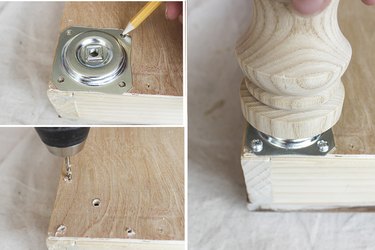
Tip
A hole for the inside corner of the plate does not need to be drilled, as it is not needed for stability and the screw would puncture through the other side of the plywood, making a sharp point coming through the inside of the desk.
Step 9: Paint the Desk
Use a 2-inch paintbrush and white latex paint + primer in semi-gloss finish to paint the entire desk, except the center of the cabinet door. Apply two coats and let dry completely. Use a 3-inch foam roller brush to paint the center of the cabinet door with chalkboard paint. Apply two to three coats and let the desk dry for 24 hours.
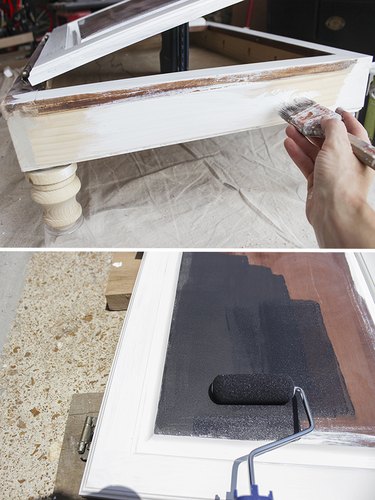
Step 10: Place Small Tin Buckets in the Holes
Place small tin buckets or cups in the four holes that were cut out earlier, and fill with crayons, pencils, chalk, scissors or other school supplies.
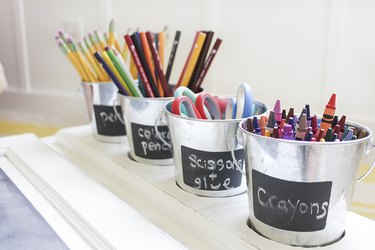
Tip
To season the chalkboard before use, fill in the entire chalkboard surface with white chalk and then wipe off. This prevents marks from first-time use from remaining visible after being wiped away.
This desk provides great storage for all school supplies, keeping it organized and accessible. The sturdy surface and solid construction will last for years, while the portability means it can be used on the floor, sitting on a couch, or in a bed.

